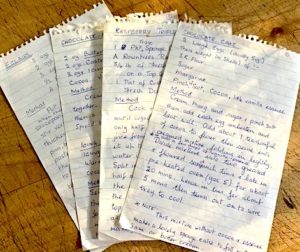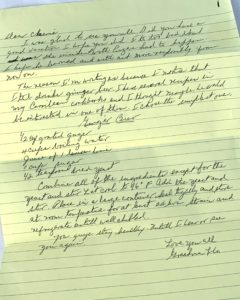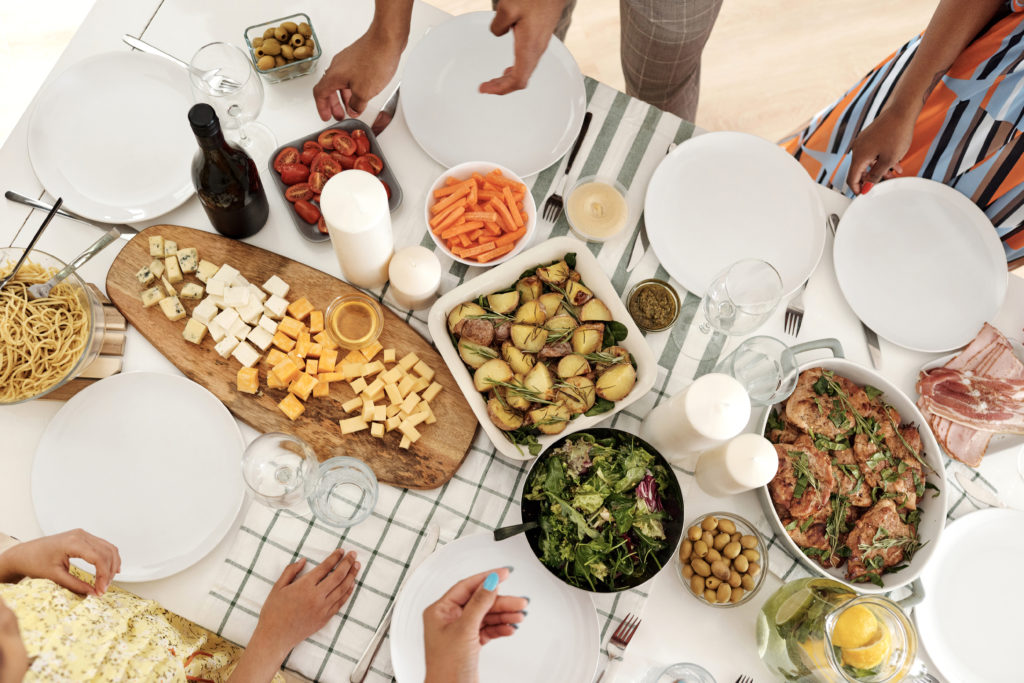At California Humanities, food is a common interest among staff. The diversity of our backgrounds offers a variety of cuisine choices from many cultures. As fall rapidly approaches, many of us are thinking about the holiday season, including cooking, eating, and spending time with loved ones. Beyond consuming delicious meals, the sharing of food creates opportunities for impromptu storytelling and reflection. This year, many of us are separated from those we care about, and the holiday table will look different as we create new ways to gather. Thinking about this shift and the upcoming season prompted us to share some of our favorite recipes that remind us of home.
Raspberry Trifle from Julie Fry
When I got married years ago and moved to England, my late mother-in-law Edna Fry wrote out a number of her dessert recipes for me. I was learning to cook with English ingredients and measures, and these recipes were so helpful. They have turned out to be some of my favorites over the years; the raspberry trifle is often part of our holiday table. I always feel like she’s with me in the kitchen when I make it, and that is very comforting and makes me smile.
Ingredients:
1 packet trifle sponge cakes
1 packet raspberry jelly (gelatin)
¾ pound of fresh or frozen raspberries, or a top-quality tin of raspberries
1 pint of custard
Fresh double cream
Method:
Cook raspberries with sugar until sugar melts. Make jelly but with only half of water, then add the juice from the raspberries to jelly, making it up to under the pint with more water if required. Split in half trifle sponges and lay half of them in a dish. Spoon over the cooked raspberries and then put the other half of the sponge cakes on top. Spoon over the jelly and leave it all to go cold and set. (If made in the morning, you can put custard on top in the evening.) Make 1 pint of custard and pour over the top, leaving it to go cold and set overnight. Before serving, whip up the double cream and spread over the top.

Madzoon from Felicia Kelley
Until I was three, my parents and I lived in a small apartment in East Hollywood that was owned by an Armenian American family in the unit upstairs. Mr. and Mrs. Mossessian had escaped the Ottoman Empire genocide and eventually found their way to California, bringing a tradition of generous hospitality along with their rich culinary heritage. Fortunately for us, they adopted our family as part of theirs, sharing stories and recipes along with their kindness and warmth. Homemade madzoon (the Armenian name for yogurt) became one of our favorite foods.
Ingredients:
The basic elements are pretty simple – all you need is milk (whole tastes best!) and some packaged yogurt with live cultures.
Method:
Scald the milk (any quantity you wish) and cool until it’s still warm but not hot. Experienced cooks test a few drops on the inside of their arm, or you can use a thermometer (110- 115 F.)
Pour the milk into sterilized containers (pint Mason jars are good) and stir a teaspoon of your “starter” into each one.
Cover and keep warm for several hours to give the culture time to develop (the longer you leave it, the tarter it will get) – we used to do this in the oven on warming setting, putting the jars in a large pan with warm water to regulate the heat. If you want to make it even easier (and foolproof), use an Instant Pot.
Enjoy, but be sure to save enough to start your next batch!
Ginger Beer from Cherie Hill
My grandmother Floris Rhea is the closest person I know directly connected to my Jamaican ancestors. Most of my knowledge regarding my West Indies heritage is thanks to her. A little over a decade ago, she sent me a handwritten recipe for making Ginger Beer. She writes, “I notice that Ithiel (my life-partner) drinks ginger beer. I have several recipes in my Caribbean cookbooks, and I thought maybe he would be interested in one of them. I chose the simplest one.”
Ingredients:
½ cup grated ginger
4 cups boiling water
Juice of 1 lime
1 cup of sugar
½ teaspoon dried yeast
Method:
Combine all ingredients except for the yeast and stir. Let cool to 96° F. Add the yeast and stir. Place in a large container, seal tightly and store at room temperature for at least 24 hours. Strain and refrigerate until well chilled.

Pan Roast from John Lightfoot
Growing up near the ocean on the East Coast as a kid, one of the benefits was being able to go out at low tide and dig for clams with my family. We’d then cook them up, put about 6 or 7 on a piece of toasted bread, smother them in melted butter, and sprinkle with smoked paprika. Super basic, but really, really good. I didn’t know it then, but this was a simplified version of a Pan Roast recipe from the Oyster Bar in Grand Central Station. So, in missing both family and the festivity of a classic New York institution like the Oyster Bar, I offer a modest but delicious recipe for the Pan Roast of my childhood.
Ingredients:
20 or so Cherrystone or Littleneck clams
Flour
Bread
Butter
Paprika
Method:
Soak in fresh water with flour for 30 minutes or more to remove any sand.
Steam in a large saucepan until shells are fully open.
Remove from shells and place clams on toasted bread of your choice, top with melted butter and dash of paprika. Or just eat clams directly out of shells, again your choice, with a splash of hot sauce for a little zip.





